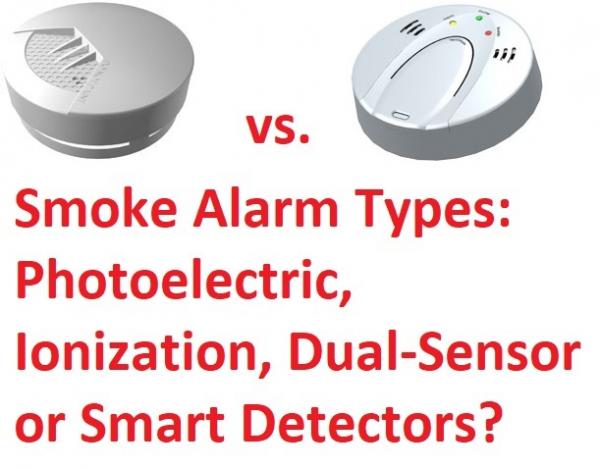Comparing Smoke Alarm Types: Choosing the Right Safety Device for Your Home

When it comes to home safety, few devices are as essential as smoke alarms. These life-saving devices can provide early warnings of fires, giving you and your loved ones precious moments to evacuate and escape harm. However, not all smoke alarms are created equal. With advancements in technology and various types of smoke alarms available on the market, it's important to understand the differences between them to make an informed choice for your home's protection.
The comparison table below provides a quick overview of the key features, advantages, and disadvantages of different types of smoke alarms. Keep in mind that the choice of the right smoke alarm type depends on your specific needs, home layout, and personal preferences.
|
Smoke Alarm Type |
Detection Focus |
Pros |
Cons |
|
Ionization |
Fast-burning, flaming fires |
Swift response to certain fires |
May not detect smoldering fires as well, radioactive materials |
|
Photoelectric |
Smoldering fires |
Effective at detecting slow-burning fires, reduced false alarms |
Potential for false alarms due to cooking or humidity |
|
Dual Sensor |
Flaming and smoldering fires |
Comprehensive fire detection, reduced false alarms |
Slightly more expensive |
|
Smart |
Various types of alarms |
Real-time alerts, remote monitoring, additional features |
Security and privacy concerns, reliance on technology, may require maintenance |
Ionization Smoke Alarms: The Agile Detectors
Ionization smoke alarms are designed to swiftly detect fast-burning, flaming fires. They contain a small amount of radioactive material that ionizes the air inside the alarm's chamber. When smoke particles enter into the smoke chamber, they disrupt the ionization process, triggering the alarm. These alarms are highly effective at detecting fires with small, rapidly moving particles, such as those produced by paper or wood fires.
However, ionization alarms have limitations. They may not respond as quickly to smoldering, slow-burning fires, which produce larger smoke particles. This could potentially delay the alarm's activation during such incidents. In addition, the presence of radioactive materials in these alarms raises environmental and disposal concerns.
Photoelectric Smoke Alarms: Smoldering Fire Guardians
Photoelectric smoke alarms are specifically designed to detect smoldering fires, which can produce a thick, opaque smoke before bursting into flames. These alarms use a light source and a sensor to detect the presence of smoke particles. When smoke enters the chamber, it scatters the light, triggering the alarm. Photoelectric alarms excel at detecting fires that start with a smoldering phase, making them a valuable addition to areas like bedrooms, hallways, and kitchens.
One downside of photoelectric alarms is their potential to trigger false alarms due to cooking activities or high humidity. Regular maintenance and proper placement can help mitigate these issues. Nevertheless, their ability to detect slow-burning fires early can provide vital escape time, especially at night when occupants are asleep.
Dual Sensor Smoke Alarms: Best of Both Worlds
To address the limitations of individual smoke alarm types, dual sensor smoke alarms combine both ionization and photoelectric technologies. These alarms aim to provide comprehensive fire detection by offering rapid response to both flaming and smoldering fires. By utilizing two distinct detection methods, dual sensor alarms reduce the likelihood of false alarms and increase overall effectiveness.
While dual sensor alarms offer a balanced approach, they can be slightly more expensive than single-sensor models. However, the added benefits in terms of enhanced fire detection and reduced false alarms make them a worthwhile investment for comprehensive home safety.
Smart Smoke Alarms: Connected Guardians
Advancements in technology have given rise to smart smoke alarms, which offer features beyond basic detection. These alarms can connect to your home's Wi-Fi network, allowing you to receive alerts and notifications on your smartphone in real-time. Some smart alarms can even differentiate between different types of alarms, such as smoke, carbon monoxide, or even steam from cooking, reducing unnecessary panic.
Smart alarms also often come with additional features like remote testing, hush functions, and battery monitoring. While they offer convenience and the ability to monitor your home's safety remotely, it's essential to ensure the security and privacy of the connected devices.
Conclusion: Making the Right Choice for Ultimate Protection
Selecting the right type of smoke alarm for your home is a critical decision that hinges on factors such as the layout of your home, your family's lifestyle, and your budget. Ionization alarms are swift responders to flaming fires, photoelectric alarms excel at detecting smoldering fires, while dual sensor alarms combine both technologies for comprehensive coverage. Smart alarms add a layer of connectivity and convenience.
To ensure optimal protection, experts recommend a multi-pronged approach by installing a combination of ionization, photoelectric, or dual sensor alarms in different areas of your home. Regular maintenance, proper placement, and keeping alarms up to latest UL standards are equally vital to ensuring your home's safety net remains strong and reliable. With the right smoke alarms in place, you can rest assured that you've taken a crucial step towards safeguarding your home and loved ones from the threat of fires.

